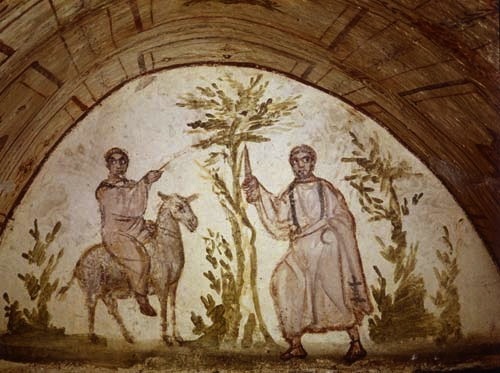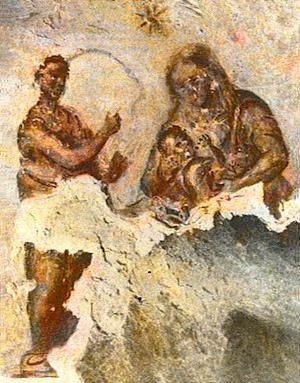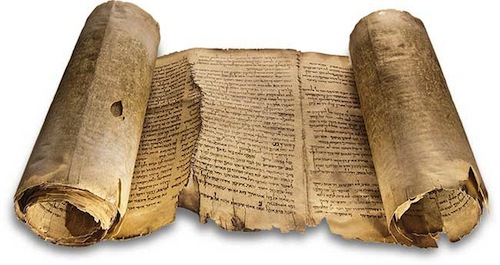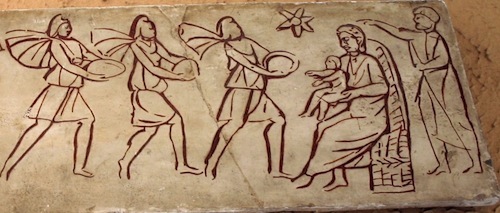
Balaam, the greedy prophet whose ass tried to deter him from cursing Israel (Numbers 22-24), is often portrayed in catacomb paintings. “Balaam, son of Beor from Pethor in Aram” (Deuteronomy 23:4) was a powerful and famous diviner in the ancient world. He was an Arab from a town near the Euphrates. Not only is he mentioned in the Old Testament, but a fragmentary plaster inscription about him was found in 1967 at Deir ‘Alla, Jordan 25 miles north of the plains of Moab where the Israelites had camped. The inscription, written in black and red ink on a plaster wall, dates to c. 800 BC. The long inscription begins: “The misfortunes of the Book of Balaam, son of Beor. A divine seer was he.”
The Arab Balaam was, also, a descendant of Abraham through his son Ishmael. He had been summoned by Balak, king of the Moabites (descendants of Noah), to curse the Israelites who were conquering the land of Canaan. The Hebrews, lean and hungry for land, had emerged from their 40 years in the wilderness a disciplined and invincible force. Balaam, tempted by the money King Balak had offered him, tried to utter curses on the Jews but could not. An angel barred Balaam’s way and even his own donkey tried to stop him from cursing the Israelites. (Numbers 22:21-39)

In spite of being paid to curse the Jews, Balaam could only pronounce praises upon them. (Numbers 23-24) In one of Balaam’s prophecies he says:
“I see him, but not now; I behold him, but not near. A star will come out of Jacob; A scepter will rise out of Israel.” Numbers 24:17

These four verses are memorialized in catacomb art not only as a Messianic prophecy but as a prediction of the Star of Bethlehem. In the Catacomb of Priscilla (c. 160’s AD). Balaam, beside the Madonna and Child (a Jew from the line of Judah, son of Jacob), is looking at them and pointing with his right arm and his forefinger extended to his foretold eight-pointed star in the sky.
Scientists and scholars have speculated for millennia about the astronomical nature of the Star of Bethlehem. Was it a nova, a sudden bright star; a triple conjunction called a conjunctio magna of Jupiter and Saturn in Pisces that took place in May of 7 BC and occurs once every 900 years; a conjunction of the Moon and Jupiter in Aries that occurred in April 6 BC; a slow-moving comet; a special astronomical manifestation created by God; or was the Star of Bethlehem something else? We will never know for sure.
Some scholars believe the above words in Numbers 24:17 belonged to an early collection of Testimonia or passages from the Old Testament prefiguring the coming of the Messiah. In the Qumran scrolls discovered in 1947, Balaam’s prophecy is one of the most frequently quoted Messianic texts.

Balaam and his star appear several times in the Catacomb of Peter and Marcellinus, in the Catacomb of Priscilla and in the Catacomb of St. Sebastian. In Priscilla Catacomb a plaster sarcophagus slab from the 200’s covered the tomb of one “Severa.”
It depicts Mary and the toddler Jesus sitting on a chair with Balaam behind them pointing to his star in the sky. In front of the Mother and Child are three men with arms and hands outstretched toward the toddler, rushing with scarves blowing in the wind, to present their gifts to young Jesus whose arms are reaching out to them. This representation is crude but the sculptor has caught the eagerness of the Magi to deliver the gifts to Jesus and the excitement of the little boy Jesus.

Of great importance to the catacomb Christians was that God used the sinful and Gentile Balaam to foretell not only Christ’s birth but to specify the star the Magi would follow to worship Him. They were echoing in their paintings the famous Messianic quote in Isaiah 49:6: “I will also make you a light for the Gentiles, that you may bring my salvation to the ends of the earth.” In their tomb art the people of the Book were rejoicing that God includes the Gentiles in His plan of salvation and they were anchoring their faith in New Testament events to Old Testament prophecies.—Sandra Sweeny Silver
